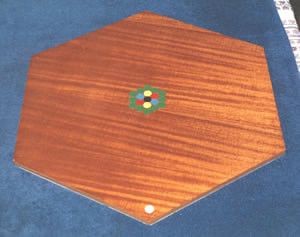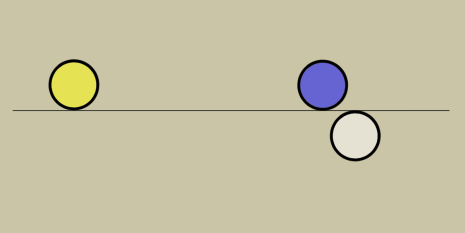The most widely played penny game of all
The twelve pennies which form the outer hexagon of the set (see below) are worth one point each.
The six pennies which form the inner hexagon are worth two points each.
The centre penny is worth six points.
When a player wins a penny, either by merit or by his opponent's mistake, he adds on its points value to his total score.
The nineteen scoring pennies add up to a total of thirty so the first player to win sixteen points or more wins the game.
When both players win fifteen points each the game is a draw.

The shooter is white and the centre coin black. Other colours are chosen from the colours of the rainbow. The colour of the coins in the outer hexagon are chosen to complement the board colour. The inner hexagon is made of three pairs of different colours.

The photograph above shows the very first Penny Black game ever made. Notice the outer hexagon was green, a green set. For a short time afterwards all games were made that way. But players soon experimented with different coloured sets and a favourite emerged. And that was the yellow set, which is most commonly used today.
On a hexagonal board - the traditional shape - the shooter is placed so that it covers one of the board's corner spots. On a square board the shooter is placed so that it covers a straight edge spot - see Overview Animation. The black is placed over the centre dot.
The other eighteen scoring pennies are placed as shown in the photograph so that a corner of the formed hexagon points directly towards the shooter.
Like colours in the inner hexagon must be placed opposite each other.
The shooter is the only penny which can be touched.
It must be flicked cleanly with the nail of one finger.
The palm of the hand should NOT move.
The shooter must NOT be nudged forward before being flicked


"Some new players try to flick with their fingers against their thumbs but their fingers are practically horizontal to the board. There's no way they can be accurate like that. The first lesson they have to learn is to keep their fingers upright."
The order in which pennies can be won by merit is simple.
First, all the pennies in the outer hexagon and last, the black. The other pennies must be knocked off in the order of the colours of the rainbow. (Red, orange, yellow, green, blue, violet, indigo)
If you flick the shooter so that it knocks off the board one penny only and stays on the board itself then you win the removed penny and go again, playing the shooter from where it came to rest.
As long as you keep winning a penny you can keep having another turn.
The shooter does NOT have to hit the colour penny which is to be won next.
For example, let's say you want to win the last green but the black is in the way between the green and the shooter. You can make the shooter hit the black on to the green. If the green is knocked off the board and all the other pennies stay on then you will have won the green. This is called a cannon.
"When I first started playing I used to just blast my way through a game. It didn't take me long to realise that I had to think my way to a high break, and look to play not only cannons but double cannons and triple cannons."
"I watched him make a Golden Guy, that's winning all the pennies by merit in one break, like a one four seven in snooker. There were about twenty five people watching and his hand was trembling like a leaf. Magic."
If you do not win a penny from a flick then you lose your turn and your opponent takes over, playing the shooter from where you left it.
However, if the shooter came off the board at the end of your turn then your opponent must start with the shooter completely covering one of the board's corner spots.
If your opponent knocks off the board one or more pennies which he can't keep, then you win them.
For example, let's say your opponent flicks the shooter. It knocks off the board the right colour but comes off itself, then your opponent loses his turn and you win the penny he knocked off.
And lastly, say your opponent flicks the shooter and it knocks off more than one penny, then you win all the pennies he knocked off in that flick, and he loses his turn.
If you flick the shooter so that it misses all the pennies on the board then you lose your go and your opponent is awarded a Free Shot.
If the shooter remained on the board at the end of your turn then the free shot must be taken from where it had come to rest.
If the shooter came off at the end of your turn then the free shot must be taken from one of the board's corner spots (There are six corner spots on a hexagonal/ circular board, and four corner spots on a square board).
From a free shot it is not necessary to win or even hit a penny in order to keep your turn. Apart from these two exceptions the free shot must be treated like any other.
For example, let's say that from your free shot the shooter knocks off the board the right colour but then comes off itself then you lose your turn and your opponent wins the removed penny.
Or say that from your free shot the shooter knocks off a wrong colour, or colours, then you lose your turn and your opponent wins the removed penny, or pennies.
Even the Penny Diameter Rule applies to free shots.
A free shot can't be saved for later. Take it straight away or lose it.
Imagine your opponent has just lost his turn and has left the shooter within a penny diameter of one or more pennies.If you come to the board and shoot, and win a penny, then carry on as normal.
But, if you don't and leave the shooter still within a penny diameter of any of those same pennies then you lose your turn and your opponent is awarded a free shot.
In the diagram below a player has finished his turn. He's left the shooter within a penny diameter of the black and the blue. The grey circles show this clearly (In a real game you would use a spare penny to check).
His opponent intended to play a cannon, hitting the green into the yellow, to knock the yellow off the board. The diagrams below shows what happened.


To take his next shot a player does not have to walk around the board to where the shooter is. Instead, he can gently turn the board into the correct position for where he is already sitting or standing.
If a player moves the board so that any penny slips over its surface then he loses his turn and a free shot is awarded to his opponent.
If a player touches any other penny on the board apart from the shooter, or does not flick the shooter cleanly, then he loses his turn and a free shot is awarded to his opponent.
If a player flicks the shooter and the result is that another penny comes to rest either wholly or partially on top of either the shooter or another penny then he has made a stack, and that's a foul. His opponent wins the penny that is on top; he removes it and takes the first flick of his new turn.
If a player flicks the shooter so that it comes to rest either wholly or partially on top of one or more pennies then he has made a stack, and that's a foul. His opponent is allowed to place the shooter on one of the board's corner spots before beginning his turn. A free shot is not awarded.
When you flick the shooter at a penny, which is near to it, then at the instant that the shooter hits the penny your finger may still be in contact with the shooter. If that is so then the flick is called a Push Shot.
If the shooter then strikes any other penny then the push shot is a Foul.
If the shooter does not strike another penny then the push shot is legal. It is not a foul.
In the diagram below it is impossisble for the shooter to hit the yellow without being pushed through the blue - a push shot. If you do push the shooter through the blue then if the shooter hits the yellow or any other penny it would be a foul.

"In
tight situations I watch my opponent like a hawk. There's no way I'll
let him get away with a push shot."
"Sometimes
the shooter is very close to the penny you're trying to hit off the board.
If you're not careful you make a push shot and the shooter goes off the
board with it. I spent hours and hours learning to make a clean hit so
that the shooter stopped dead after the hit."
"How do I keep the shooter on? I actually flick up as well as forward. It's a trick you learn pretty early on. Sometimes I literally flick the shooter up in the air. I hate it when that happens."
